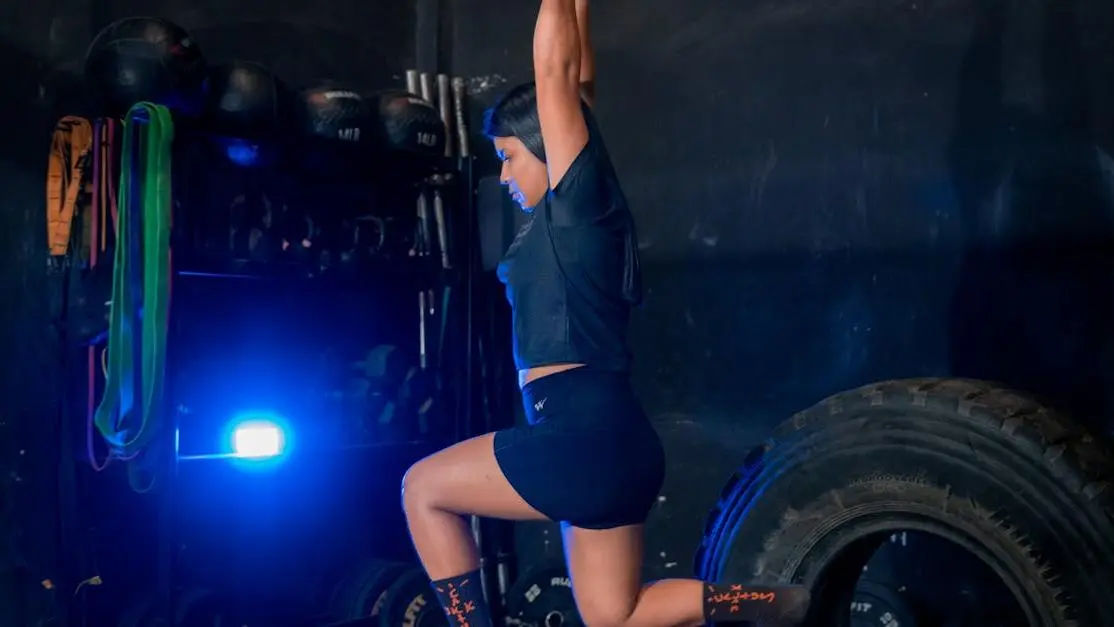When it comes to efficient and transformative workouts, nothing quite measures up to the versatility of workouts using kettlebells. As you might have noticed, these compact weights can deliver a powerful punch in both strength and cardio training regimes. It’s completely normal to feel overwhelmed by the array of kettlebell exercises out there; they do offer a ton of variety!
To help you navigate through the noise, we’ve put together an expert guide that breaks down everything you need to know about kettlebell training.
In this article, you’ll discover:
- The benefits of workouts using kettlebells, from improved strength to enhanced flexibility.
- How to choose the right kettlebell tailored to your fitness goals.
- Essential exercises and advanced routines to elevate your training game.
- What Are the Benefits of Kettlebell Workouts?
- How to Choose the Right Kettlebell for Your Workout
- Essential Kettlebell Exercises for Beginners
- Advanced Kettlebell Workouts for Experienced Lifters
- Combining Kettlebells with Other Workout Routines
- Common Mistakes to Avoid with Kettlebell Workouts
- Tips for Maximizing Your Kettlebell Workouts
- Conclusion: Start Your Kettlebell Journey Today
What Are the Benefits of Kettlebell Workouts?
Incorporating kettlebells into your fitness routine is undeniably rewarding. At Peak Performance, we emphasize the importance of functional fitness, and kettlebells are perfect for this purpose.
Improved Strength
Kettlebell workouts are exceptional for building strength because they engage multiple muscle groups simultaneously. When performing exercises like kettlebell swings or deadlifts, you recruit muscles from your core, arms, legs, and back. This full-body engagement results in comprehensive strength improvement over time.
Enhanced Cardiovascular Health
Kettlebell exercises elevate your heart rate, offering a blend of strength training and cardiovascular conditioning. A study from the American Council on Exercise (ACE) found that a single kettlebell workout can improve cardiovascular health comparable to high-intensity circuits. As you swing, press, and squat your way through a kettlebell routine, your heart and lungs work harder, promoting cardiovascular endurance.
Increased Flexibility and Mobility
Flexibility and mobility are critical for overall fitness, and kettlebell workouts deliver on both fronts. The dynamic nature of exercises like Turkish get-ups and windmills increases range of motion, improves balance, and enhances joint stability. This is particularly beneficial for athletes or anyone looking to maintain functional movement patterns in daily life.
Functional Fitness
Kettlebells mimic real-life movements, making your workouts practical and applicable to everyday activities. Unlike traditional weights that often isolate specific muscle groups, kettlebells require you to use multiple muscles synergistically. This improves coordination, agility, and overall functional fitness.
Low-Impact Exercise
For individuals seeking to avoid the wear and tear associated with high-impact activities, kettlebells offer a low-impact alternative. The fluid, swinging motions characteristic of kettlebell workouts reduce strain on the joints while still delivering an intense workout.
In summary, kettlebell workouts provide:
- Enhanced Strength: Full-body muscle engagement leads to increased strength.
- Stronger Heart: Cardiovascular health benefits akin to high-intensity circuits.
- Better Movement: Improved flexibility and mobility through dynamic exercises.
- Everyday Functionality: Movements that enhance functional fitness.
- Joint-Friendly: Low-impact exercises that are gentle on the joints.
How to Choose the Right Kettlebell for Your Workout
Selecting the correct kettlebell is crucial for effective and safe workouts. Here’s how to ensure you pick the right weight and type for your fitness level and goals.
Assess Your Fitness Level
Before anything else, gauge your current strength and fitness level. This will guide you in choosing an appropriate kettlebell weight.
- Beginners: If you are new to kettlebells, start with a manageable weight. Active men should begin with 16 kg to 20 kg, while active women should start with 8 kg to 12 kg.
- Intermediate and Advanced Users: Experienced lifters can opt for heavier kettlebells. Men can use weights between 24 kg to 32 kg, and women can consider 12 kg to 20 kg.
Think About Your Goals
What are you looking to achieve? Your specific objectives will influence your kettlebell selection.
- Strength Training: If your primary goal is to build strength, choose a heavier kettlebell to challenge your muscles.
- Cardio Conditioning: For cardiovascular workouts, a lighter kettlebell that allows for more extended sets or dynamic movements is more suitable.
Handle Design and Comfort
Ensure the kettlebell handle fits comfortably in your hand. The handle should allow a full hand grip without your fingers overlapping. A handle that’s too thick or too thin can interfere with your performance and comfort.
Types of Kettlebells
Kettlebells come in various materials and designs.
- Cast Iron Kettlebells: These are the most common and versatile. They are ideal for a wide range of exercises.
- Competition Kettlebells: These have a consistent size regardless of weight, which can be beneficial for advanced users focusing on precise lifts.
- Adjustable Kettlebells: Adjustable kettlebells allow you to change the weight, which can be cost-effective and space-saving but may have limitations in comfort and usability.
By considering your fitness level, goals, handle comfort, and the type of kettlebell, you can make an informed choice that enhances your workout experience.
Essential Kettlebell Exercises for Beginners
If you’re just starting with kettlebells, focus on mastering basic exercises that build a solid foundation. These essential exercises are effective and easy to learn.
Kettlebell Swing
The kettlebell swing is the cornerstone of kettlebell training. It engages your entire body, focusing on the hips, glutes, and core.
How to Perform:
- Stand with feet shoulder-width apart and the kettlebell between your legs.
- Grip the kettlebell handle with both hands, palms facing you.
- Bend your knees slightly, hinge at your hips, and swing the kettlebell back between your legs.
- Thrust your hips forward, swinging the kettlebell up to shoulder height.
- Let the kettlebell swing back down and repeat.
Goblet Squat
The goblet squat is excellent for targeting your legs, glutes, and core while also improving your squat form.
How to Perform:
- Hold the kettlebell by the horns at chest level, close to your body.
- Stand with your feet slightly wider than shoulder-width apart.
- Lower your body into a squat, keeping your chest up and back straight.
- Push through your heels to return to the starting position and repeat.
Kettlebell Press
The kettlebell press strengthens your shoulders, arms, and core.
How to Perform:
- Hold the kettlebell near your shoulder with your palm facing inward.
- Press the kettlebell overhead until your arm is fully extended.
- Lower the kettlebell back to the starting position.
- Perform the desired number of reps and switch arms.
Kettlebell Clean
The kettlebell clean sets up for more complex moves and works your hips, legs, and core.
How to Perform:
- Place the kettlebell between your feet.
- Hinge at your hips and grip the kettlebell handle with one hand.
- Drive through your hips to pull the kettlebell to shoulder height, rotating your wrist.
- The kettlebell should rest on your forearm at the top position.
- Lower back to the starting position and switch arms after completing the set.
Kettlebell Row
For a balanced workout, incorporate the kettlebell row to target your upper back and biceps.
How to Perform:
- Place the kettlebell on the ground and get into a staggered stance.
- Reach down and grab the kettlebell with one hand.
- Pull the kettlebell to your ribcage, keeping your elbow close to your body.
- Lower the kettlebell back down and repeat. Switch sides after completing the reps.
These essential exercises cover a range of movements to help you get started with kettlebells effectively and safely.
Advanced Kettlebell Workouts for Experienced Lifters
For those with a solid foundation looking to challenge themselves further, advanced kettlebell exercises can elevate your training.
Turkish Get-Up
The Turkish get-up is a complex, full-body movement that improves coordination, strength, and stability.
How to Perform:
- Lie on your back, holding a kettlebell in your right hand with your arm extended.
- Bend your right knee while keeping your left leg straight.
- Use your left hand for support and rise to a sitting position.
- Move through a lunge position to stand up, keeping the kettlebell overhead.
- Reverse the movement back to the starting position. Switch sides and repeat.
Kettlebell Snatch
The kettlebell snatch is an explosive movement that builds power and endurance.
How to Perform:
- Place the kettlebell between your feet.
- Hinge at your hips and grab the kettlebell with one hand.
- Explosively pull the kettlebell overhead in one fluid motion.
- Catch the kettlebell at the top, stabilizing with your arm extended.
- Lower the kettlebell back to the starting position and repeat. Switch sides after completing the reps.
Double Kettlebell Clean and Jerk
This exercise enhances dynamic stabilization and muscle engagement.
How to Perform:
- Stand with a kettlebell in each hand.
- Perform a clean by bringing both kettlebells to shoulder height.
- Dip slightly at the knees and press both kettlebells overhead.
- Lower the kettlebells back to shoulder height, then return to the starting position.
Bottoms-Up Press
The bottoms-up press increases your grip strength and stabilizes your shoulder.
How to Perform:
- Hold the kettlebell upside down by the handle at shoulder height.
- Stabilize the kettlebell and press it overhead.
- Lower it back to the starting position and repeat. Switch sides after completing the reps.
By incorporating these advanced kettlebell exercises into your routine, you can challenge your muscles in new ways and achieve greater levels of strength and coordination.
Combining Kettlebells with Other Workout Routines
Incorporating kettlebells into different workout routines can significantly enhance your fitness regime. At Peak Performance, we believe in tailoring workouts to maximize results, and kettlebells can be seamlessly integrated with other exercise forms for a comprehensive approach.
Kettlebells and HIIT
High-Intensity Interval Training (HIIT) is known for its efficiency in burning calories and improving cardiovascular fitness. Kettlebells can take your HIIT sessions to the next level by providing a dynamic and versatile element to your workouts.
- Enhanced Cardio: Replacing traditional cardio exercises with kettlebell swings or snatches can elevate your heart rate quickly, offering a robust cardiovascular workout.
- Strength and Conditioning: Kettlebell movements such as goblet squats and clean and presses can be incorporated into HIIT circuits, providing both strength and conditioning benefits.
- Variety and Engagement: Adding kettlebell exercises to your HIIT routine introduces variety, keeping your workouts engaging and preventing plateaus.
Kettlebells and CrossFit
CrossFit routines are diverse and often include functional movements and high-intensity training, making kettlebells a perfect addition.
- Functional Movements: Kettlebells align with the functional fitness principles of CrossFit by improving strength and mobility. Exercises like kettlebell swings and Turkish get-ups mimic real-life movements, enhancing functional strength.
- Scalability: Kettlebells come in various weights, making them suitable for CrossFit athletes of all levels. You can scale your workout by adjusting the kettlebell weight for different exercises.
- Dynamic Workouts: Incorporating kettlebells into your CrossFit routines, such as in WODs (Workouts of the Day), can elevate the intensity and effectiveness of your training sessions.
Kettlebells and Traditional Strength Training
Integrating kettlebells into traditional strength training routines can provide a fresh and effective approach to building muscle and strength.
- Compound Movements: Kettlebell exercises typically involve compound movements, engaging multiple muscle groups. For example, kettlebell deadlifts and squats target the legs, core, and back simultaneously.
- Stabilization and Control: Kettlebells require stabilization and control due to their off-center weight, activating additional muscles and improving overall strength. This is particularly beneficial for exercises like kettlebell rows and presses.
- Core Engagement: Many kettlebell exercises inherently engage the core, offering additional abdominal strength benefits. Movements like kettlebell swings and cleans strengthen the core while also training other muscle groups.
Integrating kettlebells with various workout styles ensures a well-rounded fitness routine that enhances strength, endurance, and mobility. This synergy can lead to improved performance and noticeable results.
Common Mistakes to Avoid with Kettlebell Workouts
Although kettlebell workouts offer numerous benefits, it’s crucial to perform exercises correctly to avoid injury. Here are some common mistakes to watch out for:
Using Incorrect Form
Improper form can undermine your workout effectiveness and lead to injuries.
- Rounded Back: Ensure you maintain a neutral spine during exercises like kettlebell swings and deadlifts. A rounded back can place undue stress on your spine.
- Poor Hip Hinge: The hip hinge is fundamental for movements such as swings. Ensure you hinge at the hips rather than squatting down, to engage the posterior chain effectively.
- Incorrect Grip: Grip the kettlebell firmly but avoid excessive tension. A relaxed grip allows for better fluidity and reduces the risk of hand or wrist strain.
Choosing the Wrong Weight
Selecting inappropriate kettlebell weights can hinder progress and increase injury risk.
- Too Heavy: Starting with a kettlebell that’s too heavy can compromise form and safety. Choose a weight that allows you to perform exercises with proper technique.
- Too Light: While lighter kettlebells are easier to manage, they may not provide enough resistance to challenge your muscles effectively. Gradually increase the weight as you build strength.
Overlooking Warm-ups and Cool-downs
Warm-ups and cool-downs are essential for preparing your body for exercise and aiding recovery.
- Skipping Warm-ups: Failing to warm up can lead to muscle strain. Incorporate dynamic stretches and light cardio to prepare your muscles.
- Ignoring Cool-downs: Post-workout, engage in static stretching and light movements to promote recovery and flexibility.
Neglecting Progression
Progression is key in strength training, including kettlebell workouts.
- Stagnating: Continuously using the same kettlebell weight can stall progress. Gradually increase the weight to challenge your muscles and stimulate growth.
- Ignoring Rest: Rest periods are crucial to allow your muscles to recover and grow. Incorporate adequate rest between workouts and within sets.
By avoiding these common mistakes, you can maximize the benefits of your kettlebell workouts while minimizing the risk of injury.
Tips for Maximizing Your Kettlebell Workouts
To get the most out of your kettlebell training sessions, follow these practical tips:
Prioritize Proper Technique
Focusing on proper form ensures you perform exercises safely and effectively.
- Form Over Speed: Execute movements deliberately with correct form rather than rushing through reps. This approach minimizes injury risk and enhances muscle engagement.
- Mirror Practice: Use a mirror to check your form during workouts. This helps identify and correct posture or alignment issues.
Create Balanced Workouts
Ensure your routine covers all major muscle groups for balanced strength and conditioning.
- Full-Body Routine: Design workouts that include upper body, lower body, and core exercises. For example, pair kettlebell swings with presses and squats for a comprehensive session.
- Variety: Incorporate different kettlebell exercises to target various muscles and prevent boredom. Rotate between exercises like clean and press, snatches, and Turkish get-ups for well-rounded training.
Monitor Your Progress
Tracking your progress can keep you motivated and focused.
- Workout Journal: Maintain a journal to note the weights used, reps completed, and how you felt during each session. Regular tracking can help identify patterns and areas for improvement.
- Set Goals: Establish short-term and long-term fitness goals. Whether it’s increasing weight or mastering a new exercise, setting clear objectives provides direction and motivation.
Stay Consistent
Consistency is key to achieving fitness goals and reaping the benefits of kettlebell training.
- Schedule Workouts: Plan your workouts and stick to a routine. Consistent training sessions contribute to steady progress and muscle growth.
- Recovery: Include rest days in your routine to allow your muscles to recover and repair. Recovery is essential for preventing overtraining and injuries.
By following these tips, you can enhance your kettlebell workouts and achieve your fitness goals effectively.
Conclusion: Start Your Kettlebell Journey Today
Kettlebell workouts offer a versatile and effective way to improve strength, flexibility, and cardiovascular health. They cater to all fitness levels and can be seamlessly integrated with various workout routines, making them an excellent addition to any fitness regimen.
At Peak Performance, we encourage you to start incorporating kettlebells into your routine today. Whether you’re a beginner learning fundamental exercises or an experienced lifter exploring advanced workouts, there’s a kettlebell routine for you. Begin your journey towards better fitness, strength, and functional mobility with kettlebells.



